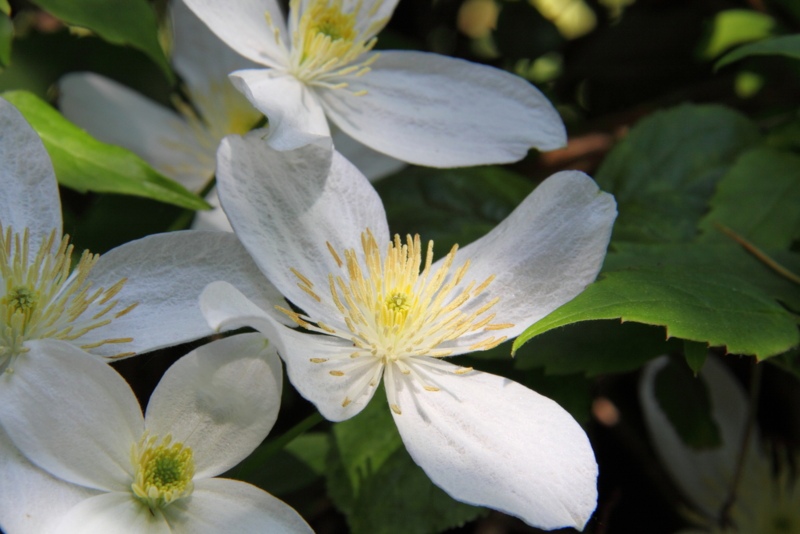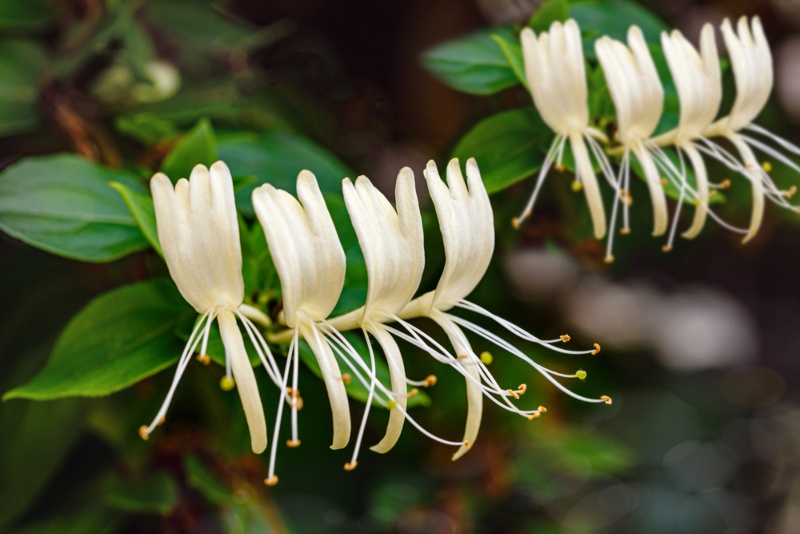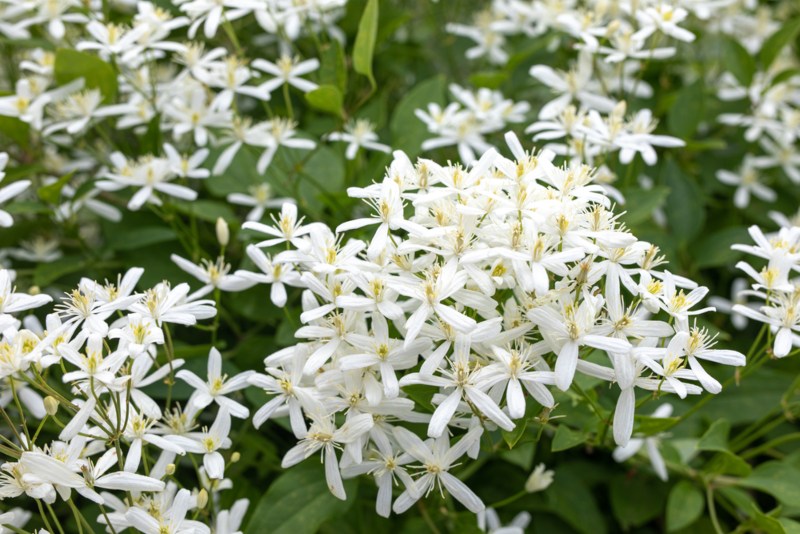
Vines can add beauty to a yard or garden and help disguise parts of the landscape you’d like to hide from view. The loose drape or climb of a vine also helps soften the edges of decks and porches.
White flowering vines can be a great choice because white flowers look fantastic next to all colors. Most white blooms have rich fragrances and often attract butterflies and hummingbirds that can make your garden space even more inviting and beautiful.
White Coral Vine (Antigonon leptopus)

The coral vine is native to Mexico and is also called the Rose of Montana. This vine grows fast and produces small, heart-shaped flowers. This climber needs full to partial sun, well-drained soil, and the support of a trellis or fence as it grows from up to 40 feet in length.
This white flowering vine is a perennial that blooms year-round in the warm USDA zones 9-11. In zone 8 and above, the plant blooms in late summer and dies off above-ground at the first freeze.
White Trumpet Vine (Thunbergia grandiflora ‘Alba’)

Trumpet vines get their name from the large trumpet-shaped flowers that attract hummingbirds. Also known as the White Sky Vine, trumpet vines grow up to 30 feet in length and flourish in USDA zones 8-11, though most trumpet vines will grow anywhere in the United States.
These perennial vines tolerate everything from full sun to partial shade and aren’t picky about the soil acidity. Well-drained soil and several hours of sun per day help the vines bloom by mid-summer.
Climbing White Jasmine (Jasminum officinale)

Jasmine is a gardening favorite that grows well in USDA zones 4-11. This variety grows fast and reaches lengths of up to 30 feet. Jasmine prefers well-drained soil that falls more on the dry side and anything from full sun to partial shade.
Jasmine is one of the white flowering vines that work well in a container or as a shrub, though you can train it to climb. This vine produces flowers in late spring until the first frost in clusters of three to five blooms that measure about 1 inch across.
White Flowering Clematis (Clematis lanuginosa ‘Candida’)

Clematis vines grow up to 15 feet, so they don’t provide the same coverage as more sprawling vines. They can be a garden showpiece on a short trellis or fence. This vine produces large, plentiful blooms in summer that can measure up to 8 inches across.
Like many white flowering vines, the clematis vine grows in USDA zones 4-11 and prefers full sun. Clematis does well in containers and grows best in well-drained soil that’s moist but not wet.
White Japanese Wisteria (Wisteria floribunda)

Wisteria vines can add drama to your garden with hanging white flowers that grow in clusters that reach up to 2 feet in length. The beautiful hanging flowers bloom in late spring in most zones.
Japanese wisteria is one of the white flowering vines that require high maintenance and a lot of water, though established plants can tolerate drought conditions.
These vines prefer full to partial sun and won’t do well in too much shade. Wisteria can reach 30 feet in length and easily spread up to 20 feet along a fence or trellis.
White Mandevilla Vine (Mandevilla boliviensis)

The Mandevilla vine is a tropical plant native to South America that does best in full sun in the hottest growing zones. This vine is one of the shorter varieties, reaching a height of up to 10 feet.
The plant is striking because of the large funnel-shaped white flowers that span up to 3 inches across. The flowers bloom throughout the summer months and have a touch of orange in their throats, making them stand out even more against the dark green leaves.
Moonflower (Ipomoea alba)

Also known as the Moon Vine, the Moonflower is a perennial vine with dark green foliage and large white blooms that can reach up to 8 inches across. The plant gets its name from its flowers that open only at night.
The Moonflower grows well throughout the USDA zones. It blooms less when the weather is cool and dies off with a freeze, though it usually reappears in all but the coldest climates. The Moonflower prefers full sun and soil that’s sandy and well-drained. This vine climbs to about 15 feet with support.
White Madagascar Jasmine (Stephanotis floribunda)

Madagascar Jasmine grows best in USDA zones 10 and 11 in partial to full sun. Dark green foliage provides a backdrop for its clusters of small white flowers that attract Eastern tiger swallowtail butterflies. Blooms can start in spring and continue until cold weather hits.
Also known as bridal wreath, this vine is a cut-flower favorite that’s easy to grow as a houseplant but can reach up to 20 feet in length outdoors. It prefers well-drained soil rich in sand and peat to lighten the density.
White Flowering Honeysuckle Vine (Lonicera albiflora)

Honeysuckle grows well as a bush or shrub, but its branches will grow up to 15 feet with support. It grows well in most zones but prefers warm climates. Honeysuckle likes full to partial sun and well-drained soil.
The flowers appear in late spring and look like two-lipped funnels with a cluster of stamens that stick out. Honeysuckle usually has a sweet smell, but this variety doesn’t have a fragrance.
Sweet Autumn Clematis (Clematis terniflora)

Unlike regular White Clematis, the flowers of this variety are small and star-shaped with thin petals that bloom in late summer until cold weather makes the plant dormant.
Clematis grows well throughout the United States with a minimum of weekly watering, more in hot climates, and protection from wind and other elements. This vine reaches 20 feet in height with support and is lovely as a cut flower.
Conclusion
Most white flowering vines are native to hot, southern climates. They can still flourish in northern states, though they’ll die off each year at the first freeze. As long as the plants do well during the growing season, they should return the following year.
Check the vines you like against a list of invasive plant species in your area, then select your favorites and prepare for beautiful spring and summer blooms.






